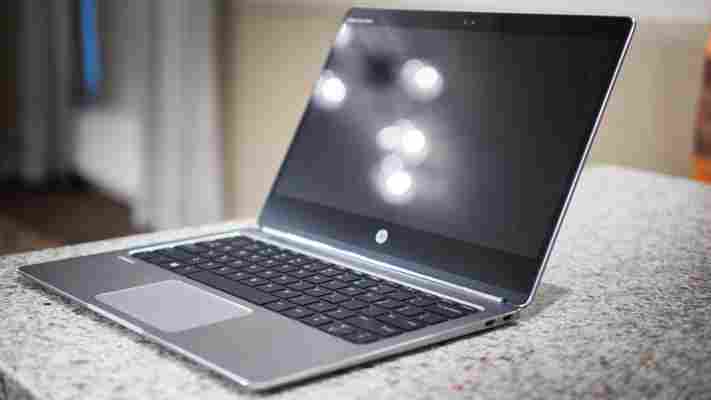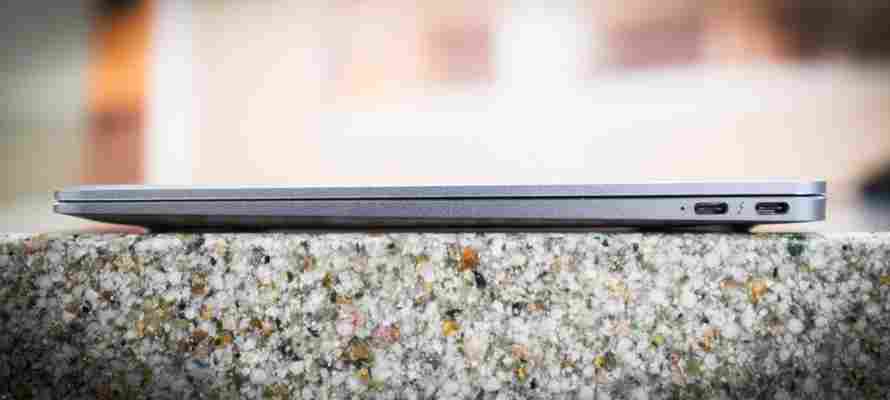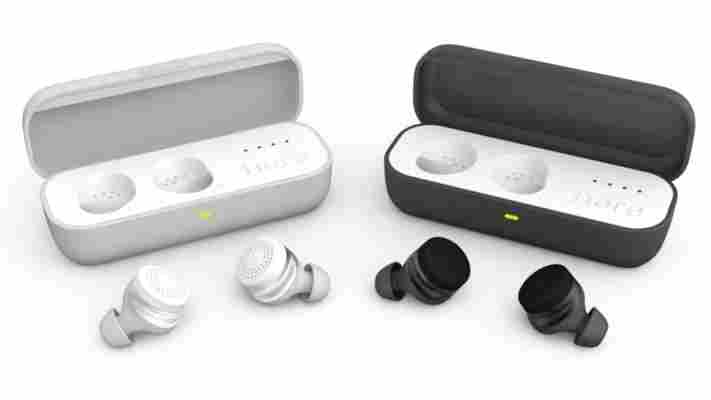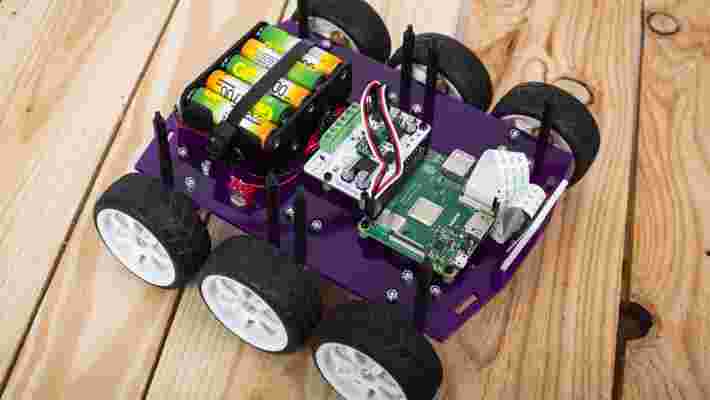Hands-on: HP’s EliteBook Folio brings the fight to Apple’s MacBook
HP is not normally the first company that comes to mind when you think of top-notch laptop design, but it just took a giant stride to make you think again. Its new EliteBook Folio sets its sights firmly on the 2015 MacBook – from what I’ve seen so far it looks like it’s going to be a fair fight.

At first glance, it ticks all the boxes. The laptop is only 12.4 mm at its thickest point and weighs 2.2 lb (versus 13.1 mm/2.03 lb on the MacBook), and comes in an attractive metallic finish. The pictures don’t really do it justice – it’s more gunmetal than silver and has a more reflective sheen than the flat matte so prevalent in Apple products.


The real stunner however, is the display, which can be be configured at either 1080p or 4k. The latter is ridiculous by laptop standards: a massive 352 ppi compared to 226 on the 12-inch MacBook.
The screen stretches out from edge to edge, giving it a larger 12.5 inch screen than the MacBook’s 12 and it’s topped by a 720p webcam above – we won’t mention how low res Apple’s version is.
The typing experience was surprisingly comfortable thanks to a full-size keyboard with decent travel, which makes me question Apple’s supposed need for the god-awful keyboard on the 12-inch MacBook (to be fair, some of my colleagues like it , but I can’t stand it).
Spec-wise, it runs on either an Intel Core m5 or Core m7 processor, which allows it to forgo fans and maintain reasonable battery life. HP says it will last up to 10 hours on a charge with the 1080p model, with an hour or two less on the 4K option.
You have the option of either 4 GB or 8 GB or RAM, and either 128 GB or 256 GB of storage on the PCIe drives.
Both panels are touchscreens, and the display can fold back 180-degrees if you happen to like using your laptop on a wall. You also get two USB-C Thunderbolt 3 ports, both of which can be used to charge the laptop or connect to other devices via a variety of accessory dongles.
We’ll need some more time with the device to see how it behaves in the real world, but the initial impressions are promising – it matches the MacBook for specs and design and has a better display, a lower starting price, a better keyboard (arguably), and a larger screen in a slightly smaller frame.
Here’s to hoping the performance and longevity live up to the design when it launches in March, starting at $999. If you want more details on the new Folio, or details on HP’s slew of other new laptops, check out the source link below
➤ HP EliteBook Folio
Here One augmented reality earbuds make your world sound exactly how you want
A few months ago, we reviewed the Here active listening system by Doppler Labs. If you’re not familiar, they are a pair of earbuds that could tune out specific sounds from your world (like a wailing baby), or help you tune into other ones (like the bass guitar at a live concert).

That made for an awesome sort of acoustic augmented reality, a step towards Doppler Labs’ goal of getting “a computer in every ear.” There was one big problem though: they didn’t stream music.
As Doppler Labs puts it, the company built a concept car, but Now its ready for mass market. The new Here One takes everything the the original earbuds did and ups the ante to something that makes a lot more sense for everyday use.
Yes, they can finally play music or answer phone calls via Bluetooth. And unlike traditional noise-cancelling headphones, they can fine-tune what sounds are cancelled out, so you can go on your daily run and still hear the world around you. You can even listen to music while maintaining a proper conversation with other people, finally adding that cinematic soundtrack to your life you’ve always wanted.
But they’re also so much more. Doppler Labs says it’s “dramatically improved” the active listening filters from its first-gen product.
While the original earbuds basically worked like an equalizer to remove entire frequency ranges (meaning anything else in that acoustic region would get filtered out as well), Here One has ‘adaptive filters’ that can identify and target specific sounds to enhance or tune them out to your liking. Think human speech, sirens, that aforementioned crying baby, a jet engine, etc.
Even cooler, the Here One come with directional mics, so you can specify the specific direction of the acoustic nuisance you want to tune out (or again, enhance).
Meanwhile, the set-up process now includes a tailoring experience. Rather than assuming everyone has the same baseline preferences, Here One will customize an audio profile. That’s particularly useful if you’re sensitive to certain frequencies or have an acoustic disorder like tinnitus.
Other details are largely the same as the predecessor. Despite all the new hardware, they’re just one millimeter thicker. They last about four to six hours on a charge (about three to four if playing music while tuning stuff out), and they still come with a nifty carrying case that can provide two extra charges.
The exciting part is still to come. Doppler Labs sees the product providing a sort of augmented reality listening experience for events, venues and businesses in the near future.
Imagine going to a museum and doing an audio tour, but actually being able to listen and discuss the artworks with the people around you. You could go to a baseball game and tuning into specific stats for on-field players without tuning out the crowd. Perhaps you’re watching a movie, and want to listen to director commentary without annoying the people next to you.
And with voice assistants (Siri, Google Assistant, Cortana, Alexa, etcs ) and bots becoming ever more prominent, the opportunities for Doppler labs are endless.
The point of it all is that you can enhance your acoustic environment – whether music or commentary – without shutting out the people around you. It’s part of the reason they’re called ‘Here;’ it’s about being engaged and enhancing your surroundings, rather than the exclusively isolated worlds of current headphones.
The Here One will begin shipping in November this year. They’ll retail for $299, and you can pre-order one now from the source link below.
The Raspberry Pi 3 Model A+ is all about battery life
Earlier today, the Raspberry Pi Foundation announced their latest affordable single-board computer: the Raspberry Pi 3 Model A+.

The Raspberry Pi 3 Model A+ is primarily aimed at those using the tiny computers for battery-powered Internet of Things (IoT) projects, and is designed with power efficiency and size in mind.
It sits as a bit of a compromise between the ultra-basic Raspberry Pi Zero and the Raspberry Pi 3 Model B+. Like the Zero, it’s designed to be as compact as possible, and measures just 65mm by 56mm. To accomplish this, the Raspberry Pi Foundation removed the board’s wired Ethernet socket, while preserving the dual-band 2.4GHz and 5GHz Wi-Fi and Bluetooth 4.2 radios.
However, the Model A+ shares the same 1.4GHZ 64-bit quad-core ARM Cortex-A53 processor as the Model B+, so it’s got more than enough computational power for IoT and robotics projects. The only bad news is that the RAM has been halved, from 1GB to 512MB of LPDDR2 SDRAM.
The existence of the Raspberry Pi 3 Model A+ is indicative of a shift in how people use these tiny computers. They’ve moved from being a staple of classrooms, and now sit the heart of countless serious IoT and robotics projects.
The Model A+ is available today from the official website , with a bargain-basement price-tag of $25. TNW will be getting one in the coming days, so stay tuned for our review!
